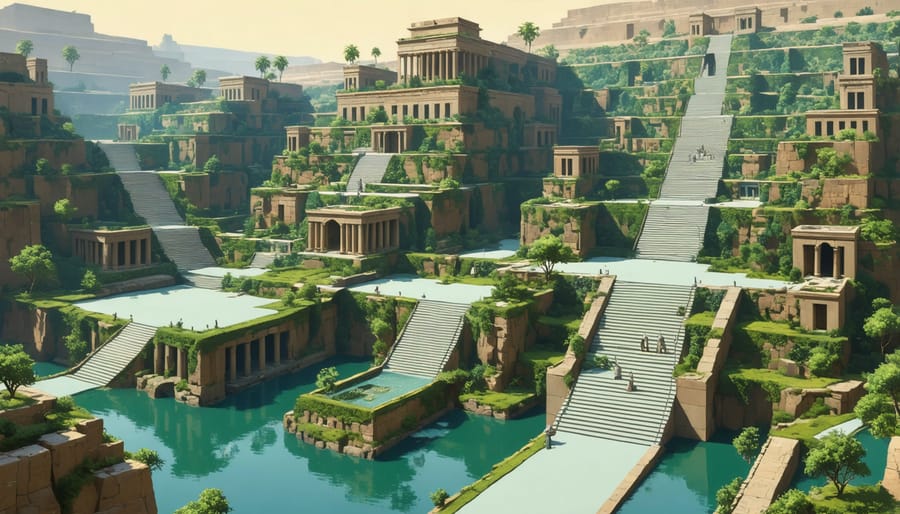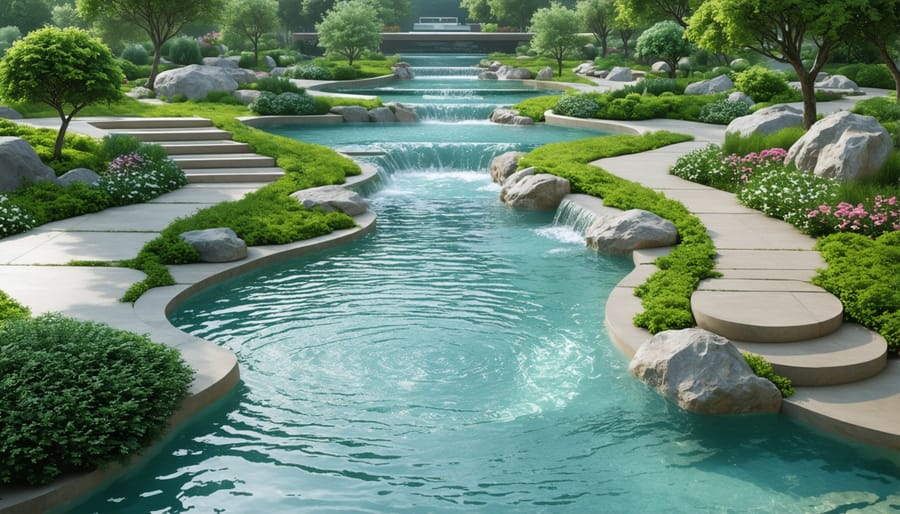
Ancient Garden Paradise: How Mythical Water Gardens Can Transform Your Pond Design
Throughout history, gardens have served as powerful symbols of paradise, enlightenment, and divine connection in mythologies across cultures. From the hanging gardens of Babylon to the ethereal gardens of the Hesperides, these mystical spaces have shaped our ancient water garden traditions and continue to inspire modern landscape design. While some mythological gardens promised immortality, others served as meeting grounds between gods and mortals, each featuring signature elements like sacred pools, magical fountains, and enchanted plant life that transcended ordinary earthly beauty.
These legendary gardens weren’t just beautiful settings for mythological tales – they reflected deep cultural beliefs about humanity’s relationship with nature and the divine. Whether it’s the Garden of Eden’s tree of life, the Celtic Avalon’s healing waters, or the Norse Idavoll’s golden games, these spaces captured imagination and spawned countless artistic interpretations throughout history. Today’s garden designers still draw inspiration from these timeless stories, incorporating elements of mystery, transformation, and sacred geometry into modern landscapes that help us reconnect with these ancient traditions of garden mysticism.

The Hanging Gardens of Babylon: Engineering Marvel and Design Inspiration
Ancient Irrigation Techniques for Modern Ponds
Ancient civilizations developed remarkably efficient irrigation systems that still inspire modern historical water garden designs. The Hanging Gardens of Babylon, for instance, used an ingenious chain pump system that we can adapt today using modern solar-powered pumps and gravity-fed water features.
One of the simplest yet most effective ancient techniques was the use of terraced levels, which naturally filtered and aerated water as it flowed downward. You can recreate this in your pond by building small cascading waterfalls or stepped streams, which not only look beautiful but also help maintain healthy oxygen levels for aquatic life.
The Romans mastered water distribution through their aqueduct system, and while we don’t need such grand structures, we can apply their principle of gentle gradients to create natural-looking streams in our gardens. Try incorporating slightly sloped channels lined with river rocks to move water efficiently while creating soothing sounds.
Ancient Egyptians used basic but clever filtration systems with sand and gravel beds – a technique that’s still relevant today. You can create your own bio-filter by layering different-sized gravels in submerged containers, letting beneficial bacteria naturally clean your pond water just as they did thousands of years ago.
Terraced Garden Elements in Water Features
The cascading gardens of ancient mythology have inspired countless modern water features, and you can bring this timeless elegance to your own backyard. Taking cues from the legendary Hanging Gardens of Babylon, terraced water features create a mesmerizing flow that draws the eye through multiple levels while soothing the senses with gentle water sounds.
Start by planning your levels, with each tier slightly lower than the previous one. This natural descent allows water to flow smoothly while creating opportunities for different plant varieties at each level. Consider incorporating small pools or basins at various heights, connected by miniature waterfalls or streaming channels.
For the most natural look, use local stone materials to build your terraces. These can be arranged in irregular patterns that mimic mountain streams, or in geometric designs that echo formal Persian gardens. Add aquatic plants like water lilies in the deeper pools, while marginal plants like iris and rushes work well in shallower areas.
Lighting plays a crucial role in terraced water features. Strategic placement of underwater lights can create magical evening effects, reminiscent of the mythical gardens that were said to glow under moonlight. Solar-powered options make this easier than ever for modern gardeners.
Remember to include maintenance access points at each level. Hidden paths behind cascading elements allow you to tend to plants and clean filters without disrupting the garden’s mystical appearance.
The Garden of Eden: Natural Paradise Elements
Creating Paradise-Inspired Plant Combinations
To create your own paradise-inspired garden, start by selecting plants that evoke a sense of lush abundance. Layer your plantings with tall, architectural specimens like banana plants and bird of paradise as focal points, then add medium-height flowering plants like hibiscus and jasmine for color and fragrance. Ground-covering plants like creeping thyme or dichondra can fill spaces between stepping stones, creating an enchanted pathway effect.
Consider incorporating plants mentioned in ancient mythology – pomegranate trees, sacred lotus, and grape vines all carry deep symbolic meaning while adding authentic touches to your design. Group plants in odd numbers and varying heights to create natural-looking clusters. Allow some plants to gracefully spill over walls or pond edges, mimicking the untamed beauty of mythological gardens.
For year-round interest, mix evergreen shrubs with seasonal bloomers. Plant night-blooming flowers like evening primrose or moonflower to add mystery after dark. Include aromatic herbs like lavender, rosemary, and mint – these not only please the senses but were often featured in ancient garden descriptions.
Remember to consider your local climate when selecting plants. While you might not be able to grow every species mentioned in mythology, you can capture the essence of these legendary gardens by choosing similar plants that thrive in your region.
Four Rivers Design Concept
The concept of four sacred rivers flows through many ancient mythologies, from the Paradise rivers of Eden to the waterways of the Greek underworld. Today, water gardeners can capture this powerful symbolism by incorporating flowing water patterns inspired by these ancient beliefs. Like the mythological rivers that brought life and prosperity, a modern four-rivers design creates dynamic movement and energy in your garden space.
Drawing from Greek water symbolism, you can create intersecting streams that meet at a central point, representing the convergence of cosmic forces. Start with a main water feature as your focal point, then design four distinct channels flowing outward or inward. Each stream can have its own character – one might cascade over rocks, another flow smoothly, the third meander through plants, and the fourth create gentle ripples.
This design works particularly well in larger gardens where you can incorporate different elevations and water speeds. For smaller spaces, consider a scaled-down version using narrow channels or even symbolic representations through pebble paths. The key is maintaining the flowing movement that connects different garden areas, just as ancient rivers connected the realms of gods and mortals.

Gardens of the Hesperides: Mediterranean Style
Golden Apple Trees and Water Features
Among the most enchanting features of mythological gardens, the combination of golden apple trees and water features stands out as a particularly captivating design element. The Gardens of the Hesperides, famous for their golden apples, showcased how fruit trees and water features could create stunning focal points in ancient garden designs.
Modern water gardeners can draw inspiration from these mythological gardens by incorporating fruit trees alongside their ponds and water features to create balanced water garden ecosystems. Dwarf apple varieties work particularly well near water features, as their roots won’t interfere with pond liners, and their fallen blossoms create magical reflections on the water’s surface.
Consider positioning fruit trees at the north side of your pond to prevent excess leaf fall while still providing partial shade for aquatic plants. The reflection of trees in still water creates a mirror effect that doubles their visual impact, while the sound of moving water adds a sensory dimension that enhances the overall garden experience.
For the best results, choose disease-resistant fruit tree varieties and position them where falling fruit won’t compromise water quality. This combination not only offers visual appeal but also attracts beneficial wildlife, creating a vibrant garden space that feels both productive and enchanted.
Dragon-Inspired Water Spouts
Throughout history, dragons have been powerful symbols of water and wisdom in gardens across various mythologies. From Chinese imperial gardens to European medieval fountains, these magnificent creatures have served both decorative and symbolic purposes in water features. The most famous example is perhaps the Dragon Fountain at the Villa d’Este in Italy, where bronze dragons spout water from their gaping mouths, creating an awe-inspiring display.
Today, you can bring this mythological charm to your own water garden with dragon-inspired spouts. These features work particularly well in Asian-inspired gardens or any space where you want to add a touch of fantasy. Modern designs range from simple dragon heads mounted on walls to elaborate full-bodied dragons that appear to emerge from the water.
When choosing a dragon spout, consider the water flow rate you desire. Traditional Chinese designs often feature dragons with open mouths that create a smooth, arcing stream of water, while European-style dragons might spray water in more dramatic patterns. For smaller gardens, a series of mini dragon spouts can create an enchanting effect without overwhelming the space.
Installation is typically straightforward – most dragon spouts can be connected to standard pond pumps and plumbing. Position them at varying heights to create dynamic water movement, or arrange them symmetrically for a more formal look. Remember to consider the sound of falling water when placing your spouts, as this adds another dimension to your garden’s sensory experience.

Modern Applications and Design Tips
Scale and Proportion in Mythical Designs
Creating a mythological-inspired garden doesn’t mean you need acres of land or a king’s treasury. The key is understanding how to scale down grand concepts while maintaining their essence. Start by identifying the core elements that make mythological gardens special – water features, symbolic plants, and defined spaces – and adapt them to fit your available area.
For smaller spaces, consider creating a miniature version of the Hanging Gardens of Babylon using tiered planters or wall-mounted containers. Even a modest balcony can accommodate cascading plants and a compact water feature to capture that legendary feeling. If the Gardens of the Hesperides inspire you, plant a dwarf citrus tree as your centerpiece instead of a full-sized golden apple tree.
Work with proportions that make sense for your space. Rather than attempting a vast reflecting pool like those in ancient tales, create depth and dimension with a small pond or even a decorative bowl fountain. Use mirrors strategically to create illusions of larger spaces, much like the legendary gardens that seemed to stretch endlessly.
Remember that mythological gardens often featured distinct zones or “rooms.” Recreate this concept by dividing your garden into smaller themed areas using pathways, archways, or different planting heights. Even in a compact garden, you can create transitions between spaces that tell a story and maintain that sense of mystery and discovery so central to mythological gardens.
The goal isn’t to exactly replicate these legendary gardens but to capture their spirit in a way that works for modern living spaces.
Material Selection for Timeless Appeal
When recreating the essence of mythological gardens, material selection plays a crucial role in achieving that timeless appeal. Natural stone stands as the foundation of ancient garden design, with limestone and slate offering the weathered, aged appearance that speaks of centuries past. Consider using rough-cut granite for pathways or marble fragments for decorative borders – these materials have been celebrated in garden design since antiquity.
For water features, copper and bronze elements develop a beautiful patina over time, much like the fountains found in ancient Roman gardens. Terra cotta pots and urns, particularly those with classical designs, add authenticity while providing practical planting solutions. These materials age gracefully, developing character that enhances their mythological connection.
Incorporating traditional building materials like exposed brick or natural wood creates structures that feel as though they’ve stood for generations. When selecting wood, opt for cedar or cypress, known for their durability and natural resistance to decay. These choices echo the construction methods of ancient garden pavilions and pergolas.
For pathways and gathering spaces, consider using gravel or crushed shell, materials that not only look appropriately aged but also provide satisfying sensory feedback underfoot. Mosaic tiles, while requiring more expertise to install, can create stunning focal points that reference classical Mediterranean gardens.
Remember, the goal isn’t to make everything look new and perfect – embrace materials that develop character over time, allowing your garden to tell its own story through the ages.
Mythological gardens have captivated imaginations for centuries, offering timeless inspiration for modern water garden enthusiasts. From the hanging gardens of Babylon to the enchanted gardens of Hesperides, these legendary spaces remind us that gardens can be more than just collections of plants – they can be magical realms that tell stories and create unforgettable experiences.
As you plan your own water garden, consider incorporating elements from these mythological wonders. A small fountain can represent the sacred springs of ancient myths, while carefully chosen statuary can evoke the divine beings who once walked these legendary gardens. Even simple features like circular pools can reference the eternal nature of mythological gardens.
You don’t need a massive space or unlimited budget to capture the spirit of these legendary gardens. Start small with a water feature that speaks to you, perhaps a trickling stream reminiscent of the rivers in Elysian Fields, or a pond filled with lotus flowers like those in ancient Egyptian paradise gardens.
Remember that every mythological garden began with a story. Your garden can tell your own story while drawing inspiration from these timeless tales. Whether you choose to recreate Atlas’s golden apple grove in miniature or design a peaceful meditation space inspired by Buddhist celestial gardens, let mythology guide you in creating a space that’s both personally meaningful and wonderfully enchanting.
